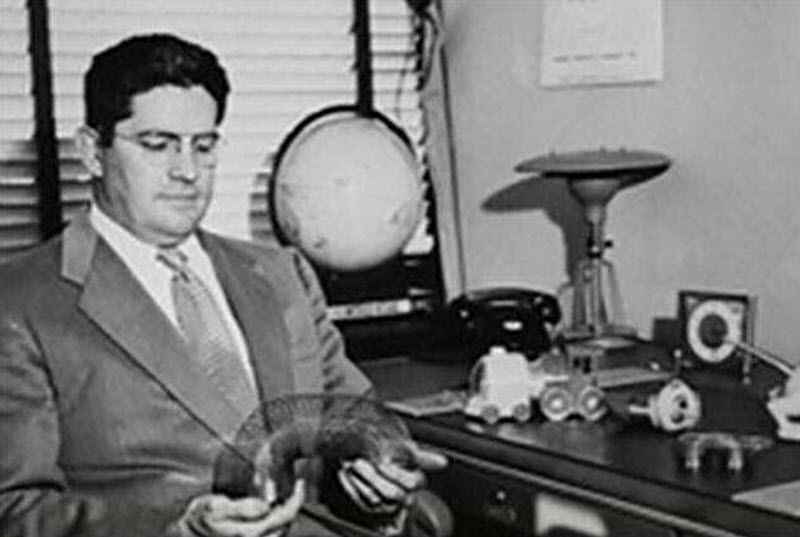Richard T. James

What walks down stairs,
Alone or in pairs,
And makes a slinkity sound?
A spring, a spring!
A marvelous thing!
Everyone knows it’s Slinky!
It’s Slinky! It’s Slinky!
For fun, it’s a wonderful toy!
It’s fun for a girl and a boy,
It’s fun for a girl and a boy!
Richard Thompson James (1918-1974) was a United States naval engineer who accidentally invented the Slinky toy in 1943 while trying to find a way of suspending sensitive shipboard instruments to keep them stable.
A Slinky is a helical spring toy that can perform a number of tricks. It can for instance “walk” down a set of stairs end-over-end as it stretches and re-forms itself with the aid of gravity and its own momentum. A Slinky can also appear to levitate for a brief period after being dropped.
Background and education
Richard Thompson James was born in Philadelphia, USA, on March 27, 1918.
- He graduated from Westtown School in Chester County, Pennsylvania in 1935. This was a Quaker boarding school.
- He got his degree in mechanical engineering from Pennsylvania State University in 1939.
The slinky toy
Invention
In 1943, James was working with torsion springs at the Cramp Shipbuilding Yard in Port Richmond, Philadelphia, trying to figure out a way of keeping sensitive shipboard instruments stable on naval vessels. He accidentally dropped one of the springs, and noticed how it kept flipping end-over-end after it hit the floor.
Richard James and his wife Betty James (née Mattas) realised a moving spring would be a fun toy for kids, so they began manufacturing torsion springs using a coil-winding machine. It was Betty that later came up with the name Slinky, after seeking inspiration from a dictionary.
Launch
The couple made 400 Slinkys in time for the 1945 Christmas shopping and convinced the department store Gimbels in Philadelphia to carry the toy. The retail price was set at $1. (To put this into perspective, a gallon of milk would cost around 60-65 cents in a store back then.)
When displayed in a static position, none of the Slinkys were sold. Richard James therefore decided to demonstrate the Slinky on a ramp, and now all 400 Slinkys sold out within 90 minutes.
Success and decline
Located in Clifton Heights, Pennsylvania, the James Spring & Wire Company was a great success as the Slinky became a very popular toy. (Later, the name of the company would be changed to James Industries.)
Swedish wire steel was used for the production of Slinkys and Richard James created special machines that could turn 80 feet of wire steel into one 2.5-inch Slinky consisting of 98 coils.
Old adds from this ear show how other toys were added to the product line, including a pull-toy Slinky train and a Slink-Em Game.
In the 1950s, Slinky sales went down, and Richard James were also making huge donations to a evangelical Christian group named the Wycliffe Bible Translators.
Betty takes the helm
In the year 1960, Richard James left his wife Betty and their six children to live with the Wycliffe Bible Translators in Bolivia.
At this point, James Industries was nearly bankrupt, but with Betty James as the CEO things began to change. Betty James moved the company from Philadelphia to Hollidaysburg in the Appalachians, and launched a new advertising campaign – one that included the now famous Slinky jingle.
Later, Betty James would explain in an 1996 interview with the New York Times: “The children then were ages 2, 4, 6, 8, 16 and 18. So, no, I wasn’t interested in South America. When we first had Slinky, we got a lot of publicity, made a lot of money, and he just didn’t handle it well. He thought he was big time. And these religious people always had their hands out. He had given so much away that I was almost bankrupt. I sold the factory and decided to move from the Philadelphia area back to Altoona, where I grew up, with the business.”
To keep production costs down, Betty James stopped using expensive imported Swedish steel and instead opted for a more affordable United States metal. It was important for her to keep the retail price down, and not even allow it to rise with inflation. If the price had been allowed to rise with inflation, the $1 price tag from 1945 would have been a $13.83 price tag in 2018.
In her 1996 interview with the New York Time, Betty James explained “So many children can’t have expensive toys, and I feel a real obligation to them. I’m appalled when I go Christmas shopping and $60 to $80 for a toy is nothing.” At that point, Slinkys retailed for $1.89 to $2.69 in the United States.
Betty James continued to run James Industries until she retired in 1998, selling the company to POOF Products in Plymouth. Three years later, she was inducted into the Toy Industry Hall of Fame. She died from congestive heart failure in 2008, aged 90. By the time of her death, Slinkys cost between $4 and $5, and the Slinky Dog (of Toy Story fame) retailed for around $20. During her lifetime, over 300 million Slinkys – counting all the variations – had been sold worldwide.
When Betty James passed away, she had then been a widow for many years, as Richard James died from a heart attack in Cochabamba in 1974, aged 56.





